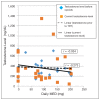Opioid-Induced Androgen Deficiency in Veterans With Chronic Nonmalignant Pain
- PMID: 30766025
- PMCID: PMC6364814
Opioid-Induced Androgen Deficiency in Veterans With Chronic Nonmalignant Pain
Abstract
Patients on chronic opioid therapy or considering it should be counseled about the risks associated with opioid-induced androgen deficiency.
Conflict of interest statement
Author disclosures The authors report no actual or potential conflicts of interest with regard to this article.
Figures




Similar articles
-
Androgen deficiency in long-term intrathecal opioid administration.Pain Physician. 2014 Jul-Aug;17(4):E543-8. Pain Physician. 2014. PMID: 25054405
-
The endocrine effects of long-term oral opioid therapy: a case report and review of the literature.J Opioid Manag. 2011 Mar-Apr;7(2):145-54. doi: 10.5055/jom.2011.0057. J Opioid Manag. 2011. PMID: 21561038 Review.
-
Association Between Commonly Prescribed Opioids and Androgen Deficiency in Men: A Retrospective Cohort Analysis.Pain Med. 2017 Apr 1;18(4):637-644. doi: 10.1093/pm/pnw182. Pain Med. 2017. PMID: 27516365 Free PMC article.
-
Opioid endocrinopathy in women consuming prescribed sustained-action opioids for control of nonmalignant pain.J Pain. 2008 Jan;9(1):28-36. doi: 10.1016/j.jpain.2007.08.005. Epub 2007 Nov 1. J Pain. 2008. PMID: 17936076
-
Management Strategies in Opioid Abuse and Sexual Dysfunction: A Review of Opioid-Induced Androgen Deficiency.Sex Med Rev. 2018 Oct;6(4):618-623. doi: 10.1016/j.sxmr.2018.04.003. Epub 2018 Jul 26. Sex Med Rev. 2018. PMID: 30057139 Review.
References
-
- Centers for Disease Control and Prevention, National Center for Injury Prevention and Control. Unintentional drug poisoning in the United States, 2010. Atlanta, GA: Centers for Disease Control and Prevention Website; [Accessed August 28, 2015]. http://www.cdc.gov/HomeandRecreationalSafety/pdf/poison-issue-brief.pdf. Published July 2010.
-
- American Academy of Family Physicians. Using opioids in the management of chronic pain patients: challenges and future options. University of Kentucky Medical Center Website. [Accessed August 28, 2015]. http://www.mc.uky.edu/equip-4-pcps/documents/CRx%20Literature/Opioids%20... Published 2010.
-
- Duarte RV, Raphael JH, Labib M, Southall JL, Ashford RL. Prevalence and influence of diagnostic criteria in the assessment of hypogonadism in intrathecal opioid therapy patients. Pain Physician. 2013;16(1):9–14. - PubMed
-
- Smith HS, Elliott JA. Opioid-induced androgen deficiency (OPIAD) Pain Physician. 2012;15(suppl 3):ES145–ES156. - PubMed
-
- De Maddalena C, Bellini M, Berra M, Meriggiola MC, Aloisi AM. Opioid-induced hypogonadism: why and how to treat it. Pain Physician. 2012;15(suppl 3):ES111–ES118. - PubMed
LinkOut - more resources
Full Text Sources
